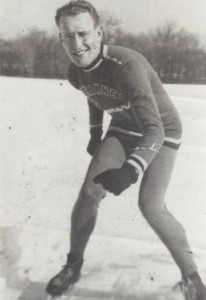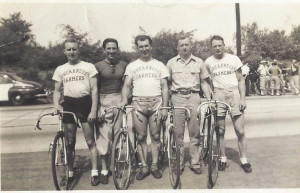Olympic writer Alan Abrahamsson talked about the problems with figure skating, and noted in there that people do not understand the new scoring system, in place since the 2002 pairs figure skating controversy. Here are the records for Olympic figure skating, both under the current system, and a listing of all the perfect 6.0 scores, under the old system – that people understood. This can also be found in our Figure Skating Factsheets – just posted today.
Olympic Records for Scoring (Current System since 2006)
Men’s Total 258.33 Yevgeny Plyushchenko (RUS-2006)
Men’s Short 90.85 Yevgeny Plyushchenko (RUS-2010)
Men’s Free 167.67 Yevgeny Plyushchenko (RUS-2006)
Women’s Total 228.56 Kim Yu-Na (KOR-2010)
Women’s Short 78.50 Kim Yu-Na (KOR-2010)
Women’s Free 150.06 Kim Yu-Na (KOR-2010)
Pairs Total 216.57 Shen Xue / Zhao Hongbo (CHN-2010)
Pairs Short 76.66 Shen Xue / Zhao Hongbo (CHN-2010)
Pairs Free 141.81 Pang Qing / Tong Jian (CHN-2010)
Dance Total 221.57 Tessa Virtue / Scott Moir (CAN-2010)
Dance Compulsory 43.76 Ok. Domnina/Mak. Shabalin (RUS-2010)
Dance OSP 68.41 Tessa Virtue / Scott Moir (CAN-2010)
Dance Free 110.42 Tessa Virtue / Scott Moir (CAN-2010)
Perfect 6.0s at the Olympics (old system – 1908-2002)
From 1908-2002 scoring in figure skating at the Olympic Winter Games was done on a basis of 0-6 points for each performance, with 6.0 being a “perfect” score, considered the ultimate performance. Following is a listing of the 55 times this was done at the Winter Olympics, fully 19 times by the British ice dance couple of Jayne Torvill and Christopher Dean, 16 of them in 1984. The next most are 7 by Heinrich Hübler and Annie Burger in 1908 pairs figure skating. (Note that in 1908 scoring was only by ½-points, so the only score above 5.5 was 6.0, which slightly devalues those scores.) This is followed by 4 by Russian singles skater Aleksey Yagudin in 2002, and by the Soviet ice dance couple of Natalia Bestemianova and Andrey Bukin in 1988.
Year Phase/Judge ScoreType Skater(s) NOC Judge
1980 Singles-SP; J#7 Req. El’m’ts Xu Zhaoxiao CHN GBR
1998 Singles-SP; J#3 Presentation Elvis Stojko CAN CAN
1936 Singles-FS; J#2 Total Score Verners Auls LAT GBR
1936 Singles-FS; J#7 Total Score Verners Auls LAT TCH
1948 Singles-FS; J#3 Total Score Per Cock-Clausen DEN USA
1988 Singles-FS; J#9 Tech. Merit Brian Orser CAN TCH
1994 Singles-FS; J#1 Tech. Merit Viktor Petrenko UKR ROU
1998 Singles-FS; J#9 Tech. Merit Philippe Candeloro FRA FRA
2002 Singles-FS; J#3 Tech. Merit Aleksey Yagudin RUS USA
2002 Singles-FS; J#4 Tech. Merit Aleksey Yagudin RUS ROU
2002 Singles-FS; J#6 Tech. Merit Aleksey Yagudin RUS GER
2002 Singles-FS; J#9 Tech. Merit Aleksey Yagudin RUS AZE
1984 Women -FS; J#4 Tech. Merit Rosalyn Sumners USA ITA
1908 Pairs-FS; J#1 Sport. Merit Hübler / Burger GER GER
1908 Pairs-FS; J#2 Sport. Merit Hübler / Burger GER SUI
1908 Pairs-FS; J#2 General Imp. Hübler / Burger GER SUI
1908 Pairs-FS; J#2 General Imp. Johnson / Johnson GBR SUI
1908 Pairs-FS; J#2 Sport. Merit Syers / Syers GBR SUI
1908 Pairs-FS; J#3 Sport. Merit Hübler / Burger GER ARG
1908 Pairs-FS; J#3 Sport. Merit Syers / Syers GBR ARG
1908 Pairs-FS; J#4 Sport. Merit Hübler / Burger GER GBR
1908 Pairs-FS; J#4 General Imp. Hübler / Burger GER GBR
1908 Pairs-FS; J#5 Sport. Merit Hübler / Burger GER RUS
1976 Pairs-SP; J#3 Req. El’m’ts Rodnina / Zaytsev URS TCH
1994 Pairs-FS; J#8 Tech. Merit Gordeyeva/Grinkov RUS RUS
1998 Pairs-FS; J#6 Tech. Merit Kazakova/Dmitriyev RUS CZE
1984 Dance-OSP; J#1 Artistic Imp. Torvill / Dean GBR HUN
1984 Dance-OSP; J#1 Tech. Merit Torvill / Dean GBR HUN
1984 Dance-OSP; J#7 Tech. Merit Torvill / Dean GBR ITA
1984 Dance-OSP; J#8 Tech. Merit Torvill / Dean GBR CAN
1988 Dance-OSP; J#9 Tech. Merit Bestiamanova/Bukin URS FRA
1994 Dance-OSP; J#3 Tech. Merit Torvill / Dean GBR GBR
1994 Dance-OSP; J#5 Tech. Merit Torvill / Dean GBR UKR
1998 Dance-OSP; J#7 Tech. Merit Krylova/Ovsyannikov RUS RUS
2002 Dance-OSP; J#1 Tech. Merit Lobacheva/Averbukh RUS POL
1976 Dance-FD; J#3 Tech. Merit Pakhomova/Gorshkov URS URS
1984 Dance-FD; J#1 Artistic Imp. Torvill / Dean GBR HUN
1984 Dance-FD; J#1 Tech. Merit Torvill / Dean GBR HUN
1984 Dance-FD; J#2 Tech. Merit Torvill / Dean GBR URS
1984 Dance-FD; J#3 Tech. Merit Torvill / Dean GBR FRG
1984 Dance-FD; J#4 Artistic Imp. Torvill / Dean GBR GBR
1984 Dance-FD; J#4 Tech. Merit Torvill / Dean GBR GBR
1984 Dance-FD; J#5 Artistic Imp. Torvill / Dean GBR JPN
1984 Dance-FD; J#5 Tech. Merit Torvill / Dean GBR JPN
1984 Dance-FD; J#6 Tech. Merit Torvill / Dean GBR TCH
1984 Dance-FD; J#7 Tech. Merit Torvill / Dean GBR ITA
1984 Dance-FD; J#8 Tech. Merit Torvill / Dean GBR CAN
1984 Dance-FD; J#9 Tech. Merit Torvill / Dean GBR USA
1988 Dance-FD; J#1 Tech. Merit Bestiamanova/Bukin URS URS
1988 Dance-FD; J#5 Tech. Merit Bestiamanova/Bukin URS ITA
1988 Dance-FD; J#9 Tech. Merit Bestiamanova/Bukin URS FRA
1994 Dance-FD; J#1 Tech. Merit Grishchuk / Platov RUS RUS
1994 Dance-FD; J#3 Tech. Merit Torvill / Dean GBR GBR
1998 Dance-FD; J#8 Tech. Merit Grishchuk / Platov RUS ITA
1998 Dance-FD; J#9 Tech. Merit Grishchuk / Platov RUS FRA
Perfect 12.0s at the Olympics (Both Scores) (old system – 1908-2002)
And under the old system, there were six occurrences when skaters received a perfect score of 12.0 for their performance, with perfect 6.0 score on both measured elements (which have differed over the years). This was done twice by the German pair of Heinrich Hübler and Annie Burger in 1908 (again with the caveat that scoring was only by ½-points), and four times by the British dance couple of Jayne Torvill and Christopher Dean in 1984.
Year Phase/Judge Type Skater(s) NOC Judge
1908 Pairs – FS; J#2 Both Hübler / Burger GER SUI
1908 Pairs – FS; J#4 Both Hübler / Burger GER GBR
1984 Dance – OSP; J#1 Both Torvill / Dean GBR HUN
1984 Dance – FD; J#1 Both Torvill / Dean GBR HUN
1984 Dance – FD; J#4 Both Torvill / Dean GBR GBR
1984 Dance – FD; J#5 Both Torvill / Dean GBR JPN

